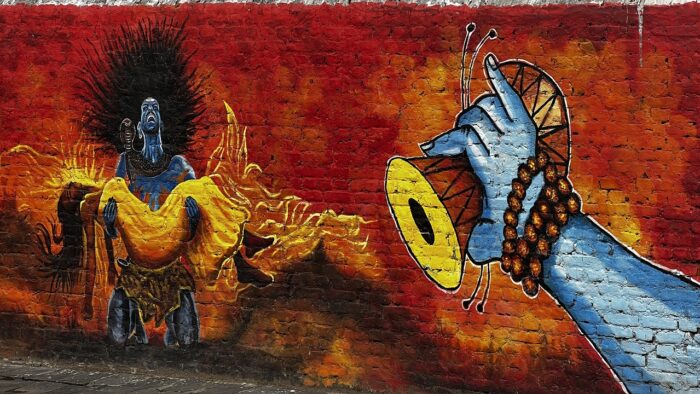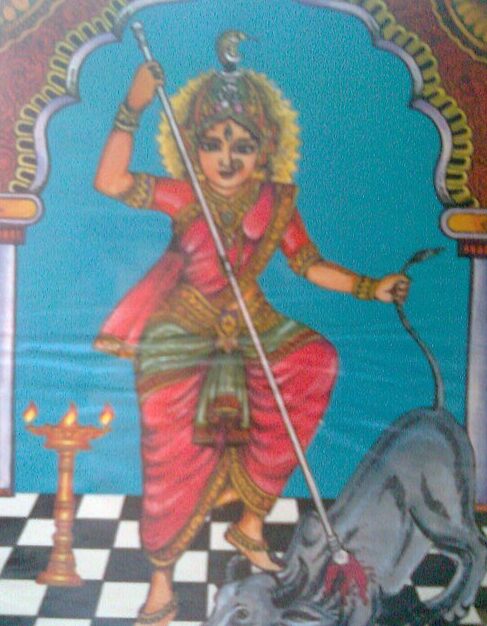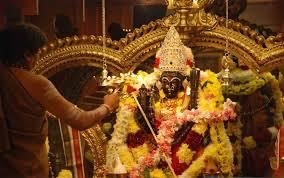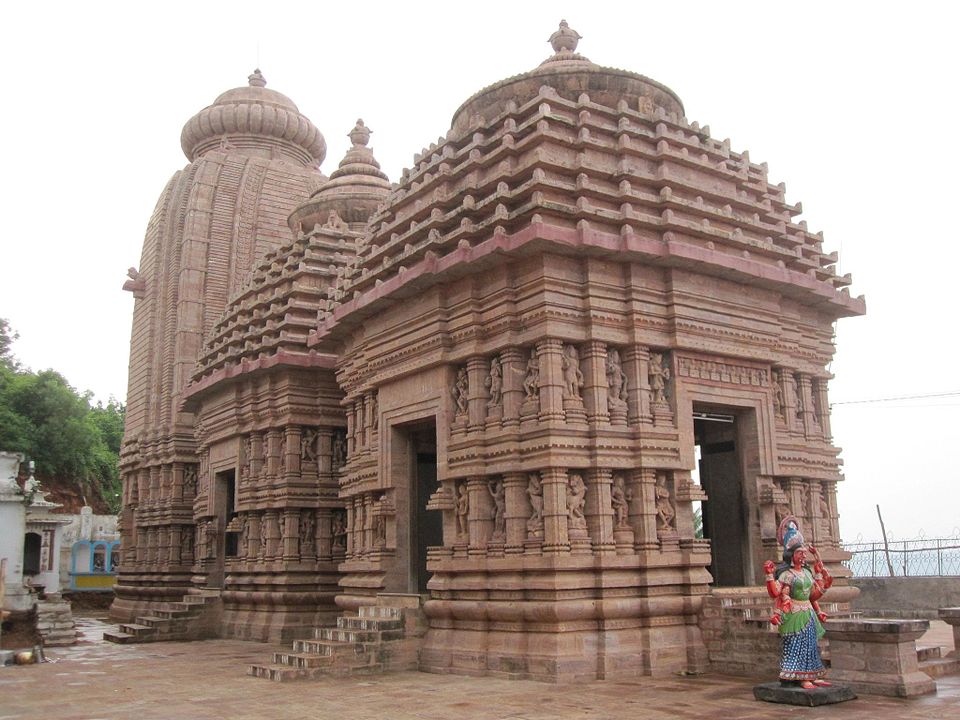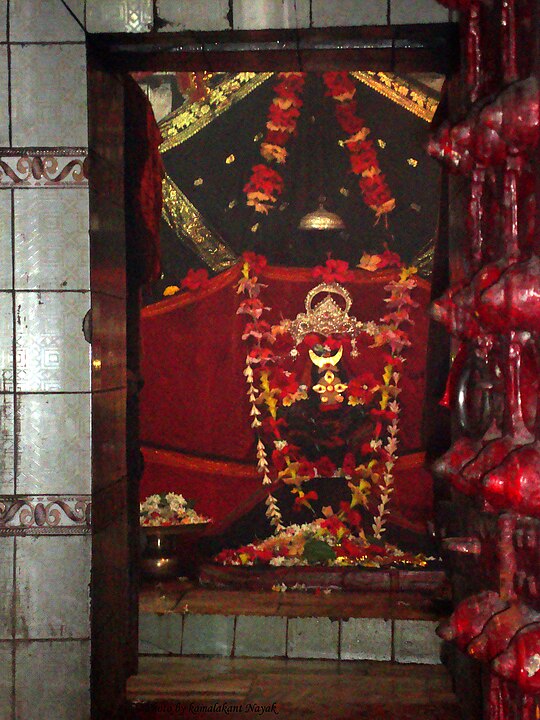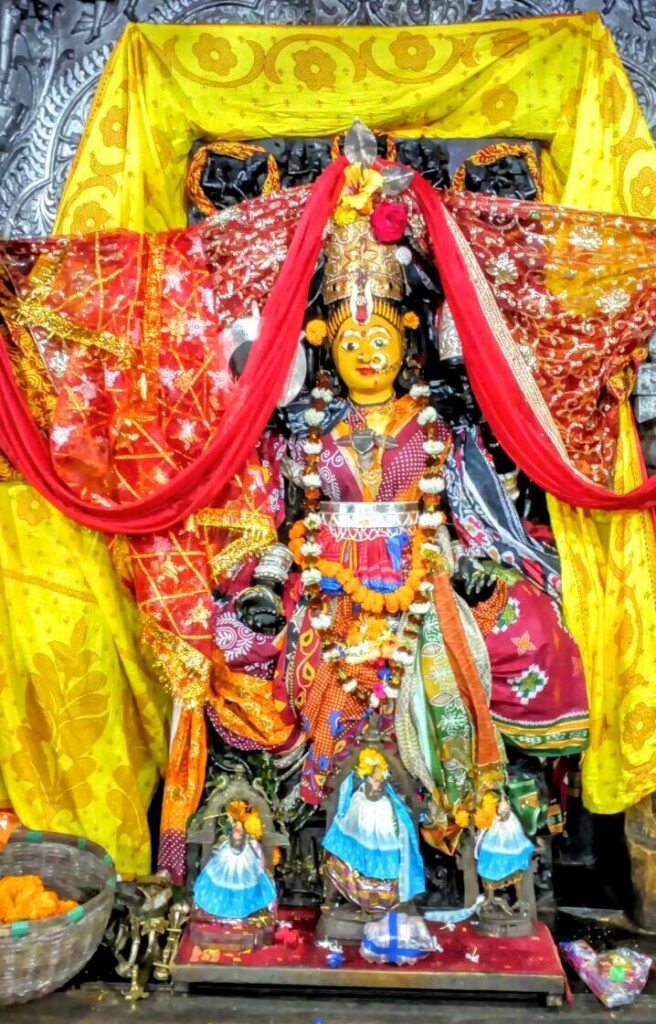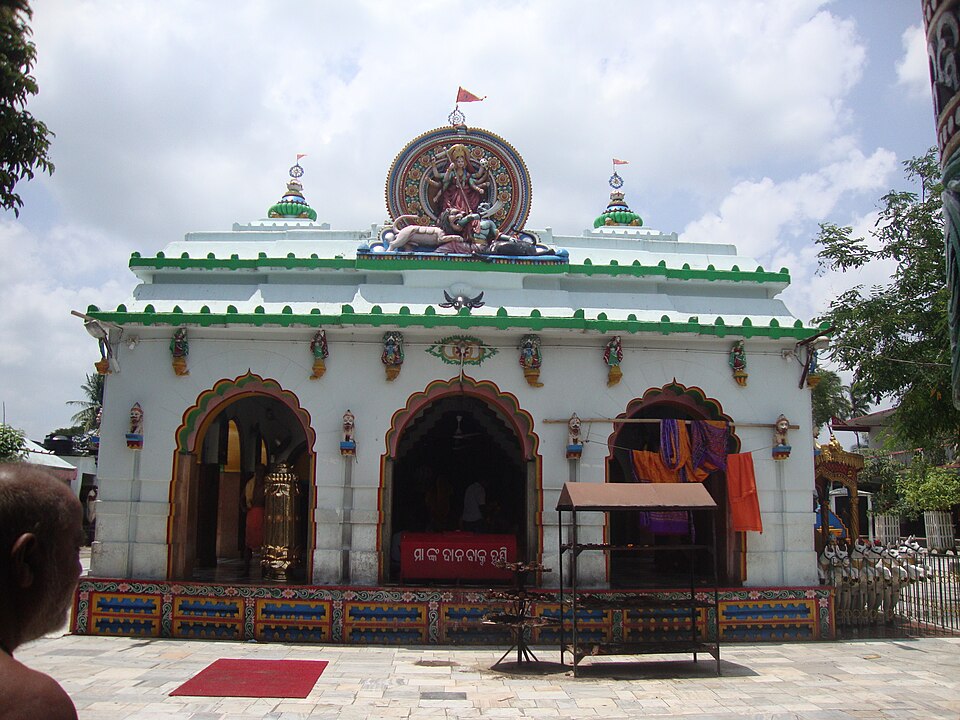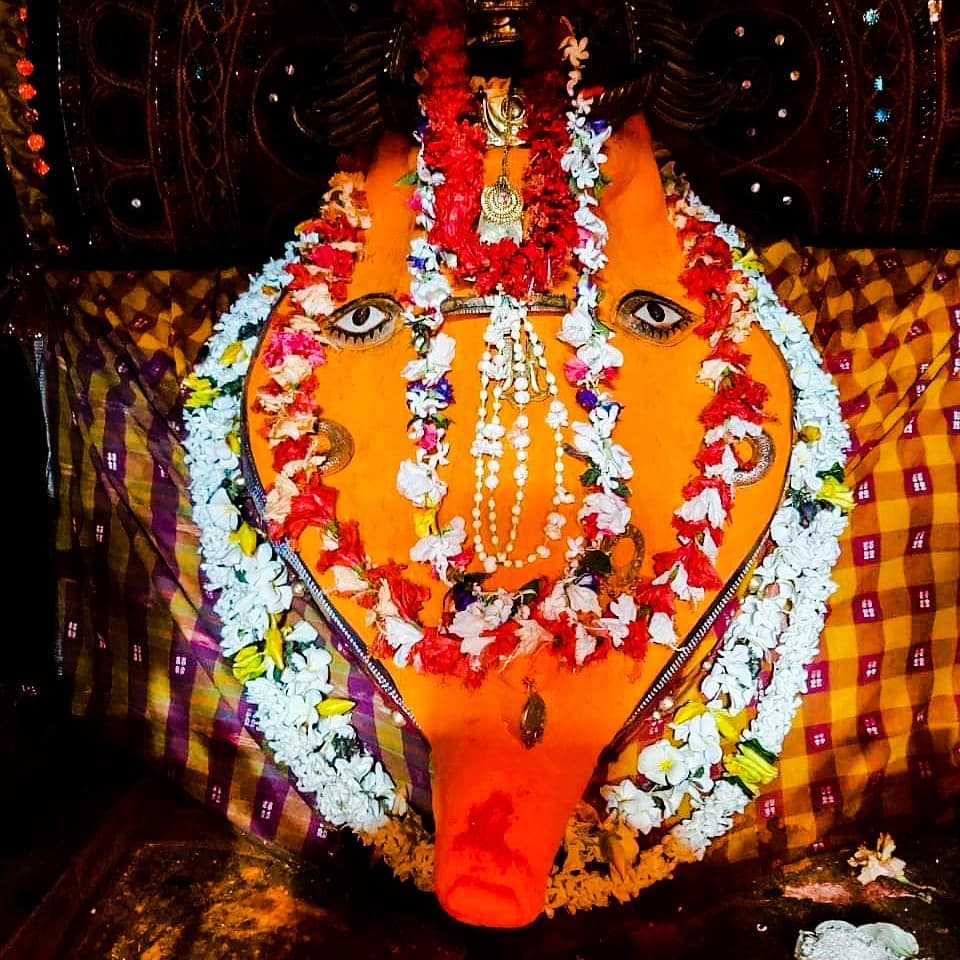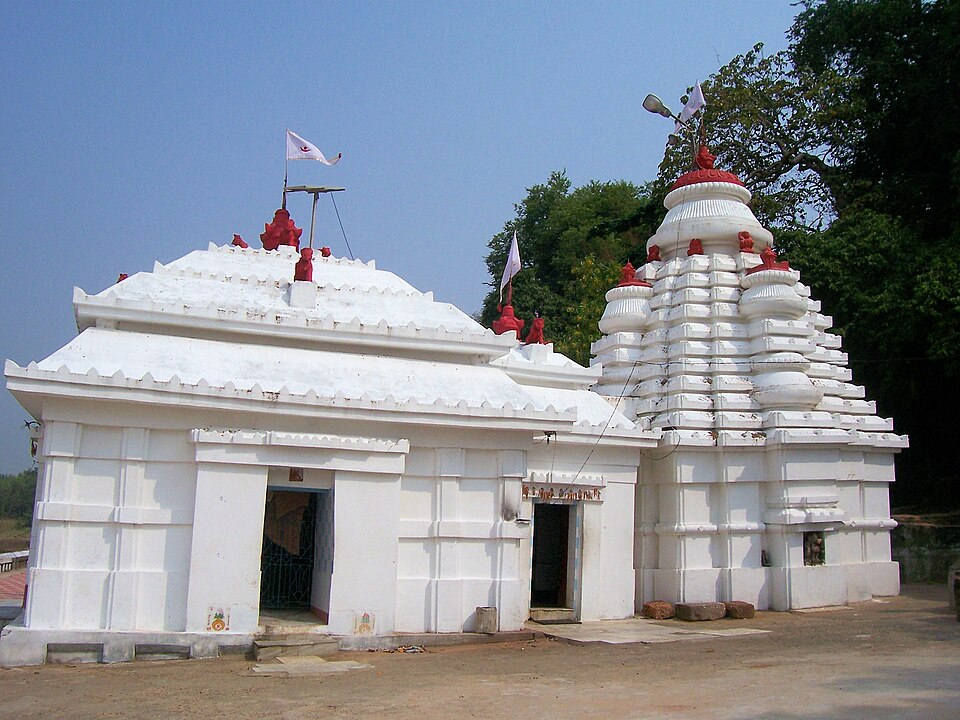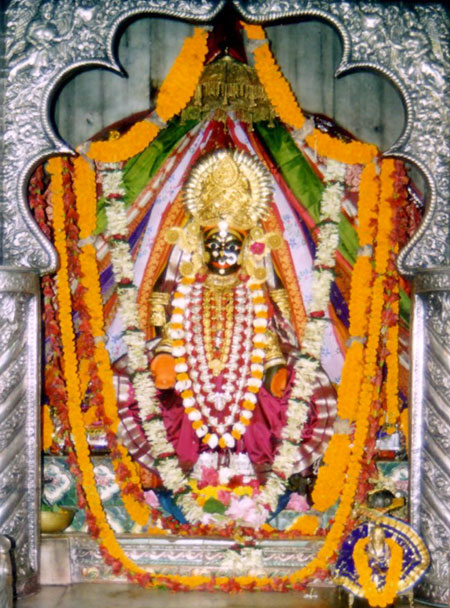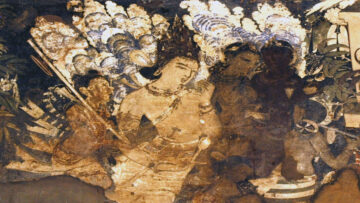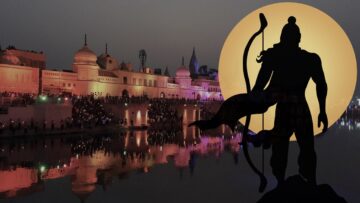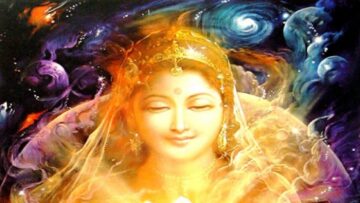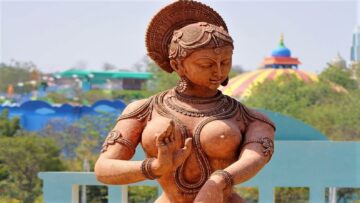The concept of Shakti in the Sanatana Dharma is conveyed with the depiction of free-spirited feminine imagery displaying exuberant power and valour, incrusted with the warmth, care and protection of a mother guardian. Shakti is the reason responsible for the creation and its protection. She stands for the termination of all evil, reassuring that the virtuous take over the malevolent. The feminine cosmic manifestation of Shakti epitomizes the power of consciousness, knowledge, desire, motivation and action.
The lines below depict the power of Shakti in the most magnificent manner
स्तुतासुरै: पुर्वमभीष्टसंश्रयात्तथासुरेंद्रेणदिनेषुसेविता |
करोतुसानःशुभहेतुरीश्वरीशुभानीभद्राण्यभिहन्तुचापदः ||२||
यासांप्रतंचोद्धतदैत्यतापितैरस्माभिरीषाचसुरैर्नमस्यते |
करोतुसानःशुभहेतुरीश्वरीशुभानिभद्राण्यभिहन्तुचापदः ||३||
-दॆवीसूक्तम्
stutāsuraiḥpūrvamabhīṣṭasaṃśrayāttathāsurendreṇadineṣusevitā ।
karotusānaḥśubhaheturīśvarī śubhānibhadrāṇyabhihantucāpadaḥ ॥
yāsāmprataṃcoddhatadaityatāpitairasmābhirīśā ca surairnamasyate ।
yā ca smṛtātatkṣaṇamevahantinaḥ sarvāpadobhaktivinamramūrtibhiḥ ॥
– Devīsūktam
(Meaning – May She who rules us, She who is the reason for all the auspiciousness, She who was admired and obliged earlier for many days by Indra and other Gods to attain their wishes, She who fragments all the threats of us Gods at the instant She is remembered, She crushes our existing calamity as we are bothered by the arrogant and intoxicated asuras; may She grace us Gods who bend down to Her and salute Her with commitment, may She grant upon us all the auspicious treasures, and conclude our anguish.)
Footprints of Shakti worship in Orissa can be found in the Copper-Plate Grant of Maharaja Tushtikara Deva, which dates back to around the 5th or 6th Century A.D. where the Goddess is referred to and worshipped as Sthambeshwari, the Goddess of Pillar worshipped in the in form of wooden or stone columns. Also referred to by the vernacular name Khambeshwari it is one of the famed amorphous indigenous idols extensively revered in the hinterlands of the Ghumusar region of Southern and western Districts of Orissa. Trails of Shakti worship have also been found in the Prachi Valley Civilization in the shape of Matsya Varahi bearing a feminine body with the face of a boar having two arms, holding a fish in the right hand and a human skull in the other. During the Bhaumakara reign between the 8th and the 10th century period, the image of the Devi got upgraded from two arms to be depicted with ten arms, the Devi with Dasa-bhuja. In Bhubaneswar, the present-day capital city of Orissa, the most prominent and ancient Shakti Shrine is the 8th century VaitāḷaDeuḷa temple. The presiding deity of the 8th-century temple is Kapalini also known as Chamunda or Charchika with a garland of skulls adorning her neck. The Goddess is depicted sitting on a carcass cordoned off by a jackal and an owl. She is seen holding a snake, a bow, armour, a sword, a trident, a thunderbolt and an arrow piercing the neck of the demon.
The reverence of SaptaMatruka- The seven mothers was another form of Shaktism practised during the Bhaumakara period. The Seven Goddesses – Varahi, Indrani, Vaishnavi, Kaumari, Sivani, Brahmani and Chamunda mostly were depicted with dwibhuja- two-armed or chaturbhuja- four-armed. The representation of SaptaMatrukas can be found at the Parasurameswar, Vaitaladeula and Mukteswar temples at Bhubaneswar.
The upsurge of Tantric Buddhism and Tantric Saivism during the Bhaumakara rule before the 10th Century A.D. gave increased popularity to Yogini worship. The Kalika Tantra Purana mentions ‘Odra’ as one of the important Brahmanical Tantric Centers of India. The Hypaethral Chausath Yogini shrine of Hirapur near Bhubaneswar and Ranipur, Jharial in Bolangir District are examples of Shakti worship in the state. These feminine yogini idols are depicted standing on an animal, a demon or a human head representing the victory of Shakti-the feminine supremacy.
The worship of Navapatrika- Nine leaves is unique to Shakti worship in Orissa which establishes the connection of flora with the Goddess of Prakruti. The Nava patrika consists of leaves from nine plants which include Rambha, Kacchvi, Haridra, Bilva, Jayanti, Asoka, Dadima, Dhanya and Manaka. Each leaf is associated with a Goddess and the presiding Godesses of each plant together are called the Nava Durga.
Popular Shakti shrines in Odisha
1. Maa Biraja- The Navi Peetha
(Figure 1: Credit: Wikipedia – Maa Biraja Devi)
The Biraja Shrine at Jajpur also known as the Girija Kshetra is a famous Shakti Peetha in Odisha and has a mention in the list of the 18 Adi Shakti Peethas. According to the Tantra Chudamani, the navel of Devi Sati fell at the place in Utkala where the present temple was erected and made it popular by the name Navikshetra -the Navel region.
The lines below confirm the presence of Devi Biraja and Devi Bimala in Utkala, Present day Orissa.
उल्कलेनाभिदेशस्तुविरजाक्षेत्रनुच्यते।
विमलासामहादेवीजगन्नाथस्तुभैरवः॥
UlkaleNābhideśastuVirajākṣetranucyate।
VimalāSāMahādevīJagannāthastuBhairavaḥ॥
-Taṃtracūḍaāmaṇī
(Meaning: In a place called Utlaka, the navel region is called the BirajaKhestra, there resides Vimala as Maha Devi and Jagannath as Bhairava.)
At the Biraja temple, we can see Shakti uniquely depicted as Goddess Durga with dwibhuja- Two Arms. She can be seen penetrating the torso of Mahisaasura depicted as a theriomorphic water buffalo demon with one hand and pulling his tail with the other hand. The lion is not seen in the portrayal which makes the idol of Goddess Durga unique. The crown adorning the head of Devi Biraja has been engraved with illustrations of Lord Ganapati, a yoni, a linga, a crescent moon and a snake.
According to Brahmanda Purana, Lord Brahma performed a yajna on the banks of river Baitarani. On Brahma’s invocation, Goddess Adi-Shakti emerged out of the sacred yagna fire as Mahisamardini with two arms and was named Biraja. Bramha implored Her to continue Her presence in the area with Her consort Lord Shiva. The Goddess acknowledged Brahma’s request and occupied Her position at the centre of the triangular region. The Goddess then in Her mind created nine Durgas, eight Chandikas and sixty-four Yoginis making the region a significant dharmic zone of worship for the Sanatanis. Goddess Biraja is also admired as the mental Pitrikanya of the ancestors and also the mental child of the AjyapaPitraganas.
2. Maa Bimala- The Pada Peetha
(Figure 2: Credit: Facebook – Maa Bimala)
Shri Jagannath the presiding deity of the Jagannath temple at Mula Dham, Puri, is accompanied by the guardian deity, Chatur Bhuja – the four-armed Goddess, Adya Shakti- Ma Bimala. It is held that when Shiva performed the Tandava holding Sati’s corpse, a part of Sati’s body part fell at Srikshetra in Puri. The Divine spot where the Pada Khanda –the foot of Devi Sati fell enshrines Goddess Bimala within Shrimandira at Puri. Shri Jagannath also represents Bhairava and Goddess Bimala is Bhairavi. A couplet in The Devi Bhagvat Purana mentions that in Odisha, Vimala is Parashakti and Pureshvari, the source of the creation of the universe, residing in the City of Jewels.
3. Maa Tara Tarini – The Stana Peetha
(Figure 3: Credit: Wikipedia – Maa Tara Tarini temple in Ganjam District of Orissa)
Situated in the Southern Part of Orissa in the Ganjam District, the temple of Tara-Tarini is dedicated to the twin sisters Tara and Tarini. Situated on the Kumari Hills beside the river Rushikulya it is believed that the breasts of Devi Sati fell at the place where the present temple stands, thus making Tara Tarini famous as a Shakti Peetha. The Kalika Purana (Asthashakti) mentions the Tara-Tarini Peetha as the Stana Peetha. The deity is represented with two stones, adorned with ornaments. Two brass mask heads are placed between these stones and are worshipped as the Chalanti Pratima.
The Tara-Tarini temple is an established Hindu and Buddhist Tantric site. The temple is also a famous pilgrimage for the Buddhists as they are devotees of Goddess Tara, the mother of all Buddhas.
As per legend, the present temple was built by a Brahmin named Basu Praharaj. Goddess Sati appeared in Basu Praharaj’s dream and instructed him to rear twin daughters and father them with utmost sincerity. Basu Praharaj followed the instructions and reared the twin girls with utmost dedication. Once his daughters suddenly vanished leaving Basu Praharaj worried. He again had a Divine vision and, in his dreams, he was instructed by the Goddess to build a temple on the Purnagiri hill and establish the twin sisters for public worship.
4. Maa Charchika of Banki
(Figure 4: Credit: Wikipedia – Shringar of Maa Charchika, the eight armed Goddess)
Situated on the Banks of river Renuka on the Ruchika hill at Banki, Maa Charchika is the eight-armed Shakti depicted as Chamunda. The main temple of the Goddess was built in the 10th century AD by the Bhoumakara dynasty. Goddess Charchika is seen sitting on a prostrating human body with a garland of human skulls adorning her neck. She is seen holding a khadga, a shula, a katari and varadamudra in her four right hands and in her four left hands she holds a severed head, a vessel of blood, a damru, and the remaining hand is immersed in blood, leaving just a finger.
Legend has it that once a Saint named Jamadagni asked his son Mahavir Parshuram to behead his mother Renuka. Mahavir Parshuram did it instinctively. But later, he regretted the act and sat in meditation on the Ruchika hill. He created the idol of Goddess Chamunda on whose lap Shiva as Mahakala slept. When Mahavir Parshuram succeeded in freeing himself from the sin he had committed, he drew the water path from the nearby river Mahanadi and named it Renuka River in memory of his mother. Thereafter the then king of Banki built a temple for the worship of the deity.
5. Maa Mangala of Kakatpur
(Figure 5 – Credit: Wikipedia – Maa Mangala of Kakatpur)
The Presiding Shakti deity of the Kakatpur region en route to Konarka lies the Maa Mangala temple. The Goddess symbolizes qualities of harmony, power, happiness, love, purity, knowledge & truth. During the Nabakalebara -the life-changing ceremony of Lord Jagannath it is customary for the Sevayats of the Srimandira to visit the Kakatpur Mangala temple to seek Divine guidance. As per legend Goddess Mangala was worshipped by Ravana in Lanka and gathered her blessings to become the most powerful. After being defeated in war by Lord Rama, the deity was taken to Utkala by a maritime trader. The trader installed the deity in the Prachi Valley for worship.
It is believed that Goddess Mangala kept herself hidden under the deep water of river Prachi until being recovered by a boatman on the instruction of the Goddess herself. The boatman dived into the water and recovered the idol of the goddess from the bed of the river and then as per the Divine direction of the Goddess installed her in the temple at Mangalapur village. After establishing the deity the the boatman saw a crow dive into the water of the Prachi River. The crow did not come out of the water for days and remained immersed inside the water in the same place from where he recovered the idol of Goddess Mangala. In vernacular Odia, Crow is addressed as Kaa-kaw and Detained means Aw-taw-ka. By combining the two words Kakaw and Awtaka, the Mangalapur village came to be known as Kakatapur and the presiding Goddess gained popularity as Kakatpur Mangala. The present temple was made in 1548 AD by a local zamindar.
6. Maa Hingula In Talcher
Maa Hingula is considered the eternal fire Goddess who remains ignited in the kitchen of the Srimandira of Shri Jagannath at the Moola Dham at Puri. It is believed that the Goddess was worshipped by King Nala in Karachi now situated in Pakistan. With time the Nala dynasty ruled the Vidharbha region of Maharashtra and brought the deity along with them for worship to Vidharbha.
As per legend, when Queen Gundicha wanted to offer sixty-four food items to Shri Jagannath, she sought Lord Jagannath’s permission to proceed with the ritualistic preparation and offering of the food. Shri Jagannath appeared in King Indradyumna’s dream and ordered him to get Goddess Hingula to remain in the Srimandira Rosa Gruha as fire. The king undertook a journey to Vidharbha to get Goddess Hingula. He got her as fire and on his way back he rested on the banks of the Sighada river, near Gopalgarh at Talcher. It is here the present Hingula Devi temple has been erected.
Every year, in the month of Chaitra on Shukla Chaturdashi Goddess Hingula takes leave from the Srimandira kitchen and gives darshan to her devotees in the Hingulajatra. The Goddess gives darshan to Her devotees a the burning fire at a place near the Hingula temple in Gopal Prasad. Goddess Hingula receives worship at Gopal Prasad her ‘Puja Sthali’ and the Goddess, Shrimandira of Shri Jagannath is Her ‘Karma Sthali.’
7. Maa Sarala in Jhankada
(Figure 6: Credit: Wikimedia- Maa Sarala Temple in Jhankada)
Another manifestation of the cosmic mother is Goddess Sarala who is the amalgamated representation of both Devi Durga and Devi Saraswati. As per legend Shri Parasuram, the sixth incarnation of Shri Vishnu carved Devi Sarala with his arrow and worshipped her for knowledge and power. It is also believed that the tongue of Devi Sati fell at Jhankada making it a Shakti Peetaha.
The main temple has three idols of the Goddess. Goddess Sarala is said to possess Shiva’s trident, Vishnu’s Chakra, Vayu’s bow, Surya’s arrow, and Vishwakarma’s Axe. Indra’s thunderbolt, Ayiravata’s bell and Himavan’s Lion. The presiding deity, Devi Sarala is carved out of a stone with eight arms in company with the lion as her mount. She is seen in the Mahisamardini posture, holding a sword, trident, a book, and a veena in her right hand. She is seen holding a disk, bow, bell and the head of a slaughtered demon in her left hand. The second idol is four-armed, holding a conch shell and a disk, making gestures of gifting and fearlessness. The third idol is made with an alloy of eight metals.
The present temple at Jhankada in Jagatsinghpur District of Orissa was constructed during the Maratha rule between 1753 and 1803.
8. Maa Bhagabati in Banpur
Maa Bhagabati is the presiding Shakti deity of Banapur. The temple of Bhagavati is located on the banks of river Salia. According to legend, Goddess Bhagavati was the custodial deity of the demon -king Banasura. Bhagavati was initially worshipped under a tree and was offered goats, buffalos and human beings. The present sanctum was constructed by the king of the Rathor reign. The shrine is a major tantric seat.
9. Maa Samaleswari in Sambalpur
(Figure 7: Credit: Facebook – Maa Samleshwari smeared with vermillion)
Goddess Samleshwari popularly known as Samalei was initially revered by the indigenous tribals of the area. Sambalpur has derived her name from the Goddess Samaleswari or Samalei.
During the 16th century A.D., she was propitiated by Chowhans, the rulers of the land as their tutelary deity. Sambalpur has derived her name from the Goddess Samaleswari or Samalei. The iconography of the idol of Goddess Samalei does not share a resemblance with any Hindu Goddess. The idol is a monolith, the middle of which is a little elevated with two depressions on both sides and a groove underneath representing the mouth. Gold plates designed to the shape of eyes are pressed above the depressions representing the eyes of the mother. She looks smeared throughout the year with the vermillion except on the new moon day in the month of Ashwin. During this period she is plastered with sandal paste and looks white.
10. Maa Bhattarika in Badamba
(Figure 8: Credit: Wikipedia – Maa Bhattarika Temple in Badamba)
The Shakti shrine of Bhattarika is nestled on the banks of the river Mahanadi, near Badamba of Cuttack District. As per legend, the deity has an association with Shri Parashurama, the sixth incarnate of Lord Vishnu who got a boon from the Goddess Mother through his deep dedicated meditation and demolished all the kings known as Bhattas of the world, establishing peoples’ government. Thus the Goddess derived her name ‘Bhattarika’, the destroyer of kings. The other name of the Goddess is ‘Brihadamba’ (Brihat + Amba), the great Mother from which the place derived its name ‘Badamba’. The present-day shrine was erected by King Phakir Mangaraj Mohapatra around 300 years ago. The reigning deity, Devi Bhattarika is seated cross-legged on a full-bloomed lotus pedestal holding a full-blown lotus in her left hand and Barada Mudra in the right hand. The original temple was constructed during the regime of King Hatta Kishore and Malla Kishore in the 13th century A.D. The present-day shrine was erected by King Phakir Mangaraj Mohapatra around 300 years ago. Bhattarika is honoured as ‘Tripura Sundari’ of Dashamahavidya and addressed in prayer as “Maa Rajarajeswari Mahamaya Tripura Sundari Siddhi Bhattarika” and in short ‘Tripura’ in her rituals although her iconographic features correspond with the image of the Buddhist Goddess Tara Devi. Non-vegetarian food is offered to the Goddess with green coconut water in a bowl of bell-metal.
11. Maa Gouri in Bhubaneswar
The Swarnadri Mahodaya and Kapila Samhita of the fifteen century A.D. has a mention of Goddess Shakti in the form of Gouri in Ekamrakshetra at, Bhubaneswar. Lord Lingaraj is celebrated as the Supreme God and Gouri as the Supreme Goddess.
Gouri is considered to be the Supreme Goddess of eight Chandikas of Bhubaneswar that includes Kapali, Gouri, Uttarayani, Ambika, Dwarabasini, Bindhya basini, Dakshina Chandi and Ramayani. Goddess Gauri stands on a fully bloomed lotus with four arms holding a noose in the right-top hand, a garland of beads in the bottom-right hand, a goat in the left top hand and Barada Mudra in the left bottom hand. Her female partners, Jaya and Vijaya, stand on both sides. To the left of her foot stands a deer and to the right side stands a lion respectively. Gouri is the goddess of Vaishnavites. The 9th century A.D. temple was constructed by Subhakara Dev of the Bhouma dynasty and his queen Tribhuban Mahadevi.
12. Maa Kataka Chandi in Cuttack
(Figure 9: Credit: Wikipedia – Goddess Katak Chandi)
The reincarnation of Shakti as Chandi is famous in Cuttack as Maa Kataka Chandi. Devi Katak Chandi is believed to be the living Goddess of the millennium city of Cuttack and is worshipped for granting wishes. The Goddess with four hands is seen holding a noose, and a goad; She carries gestures of dismissing fear and that of granting boons. Every day She is worshipped by Brahmins as Bhuvaneshvari Mahavidya, the queen of the universe. Goddess Katak Chandi was initially worshipped in the Barabati Fort of Cuttack but was later shifted to the present place due to the attack of the Muslim invader, Kalapahad in 1569 A.D.
The other shrines of Shakti worship in Orissa include Bag Dev, Narayani, Barunei, Ugratara, Maninaga, Kali Jai, Pattakhanda Devi, Baral Devi, Khichakeswari, Bhadrakali, Ghatagaon Tarini, Kanta Devi, Ramchandi, Bali Harachandi, Navadurga, Sapta Matrika, Astha Chandika, Chousathi Yogini, Sureswari, Manikesvari, Sitalei, Budhi Samalei and Lankesvari.
The mention of Orissa in the Kalika Purana, a treatise on Saktism, mentions ‘Odra’ rajya as one with foremost importance amongst the major four ‘Saktipithas’, the other three being ‘Jala Sailakam’, now Jullundur in Punjab, ‘Srimukhalingam’ in Andhra Pradesh, and ‘Kamarupa’ in Assam. Thus, Shakti “or “Durga” in its varied forms is the most revered deity at the various shrines of Orissa.
Disclaimer: The opinions expressed in this article belong to the author. Indic Today is neither responsible nor liable for the accuracy, completeness, suitability, or validity of any information in the article.

